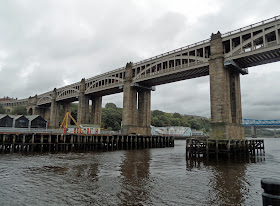Stephenson was in the vanguard of railway bridge engineering when he designed the High Level Bridge.
 Two years before, in 1847, his cast-iron bridge over the River Dee for the Chester and Holyhead Railway, had collapsed while carrying a train, killing five people. Stephenson's design for that bridge had been deeply flawed, and he was lucky to survive the subsequent commission of inquiry with his reputation largely intact.
Two years before, in 1847, his cast-iron bridge over the River Dee for the Chester and Holyhead Railway, had collapsed while carrying a train, killing five people. Stephenson's design for that bridge had been deeply flawed, and he was lucky to survive the subsequent commission of inquiry with his reputation largely intact.Working with William Fairbairn, Stephenson designed and built two tubular wrought iron rail bridges, at Conwy (1848) and Britannia (1850). These were hugely innovative, and although the tubular concept was a dead end, they were the forerunners of modern box girder bridges.
 The High Level Bridge was in my opinion a greater achievement for Stephenson, although it too built upon the work of another engineer. Benjamin Green had proposed a design for a bridge at this site, to consist of tall stone arches carrying a roadway, with iron girders supported above to carry a railway. We had encountered one of Green's bridges, at Ouseburn, earlier the same day. (Another claimant to the design was William Martin, an eccentric philosopher, who published a pamphlet illustrating a very similar design, and claimed that Stephenson had stolen his idea).
The High Level Bridge was in my opinion a greater achievement for Stephenson, although it too built upon the work of another engineer. Benjamin Green had proposed a design for a bridge at this site, to consist of tall stone arches carrying a roadway, with iron girders supported above to carry a railway. We had encountered one of Green's bridges, at Ouseburn, earlier the same day. (Another claimant to the design was William Martin, an eccentric philosopher, who published a pamphlet illustrating a very similar design, and claimed that Stephenson had stolen his idea). Stephenson adapted Green's concept by eliminating the stone arches and by using cast-iron arches to support both roadway and railway. Hollow vertical pillars extend above and below the arches; above, to support the railway, while below, they conceal wrought-iron tie rods from which the road-deck is suspended.
Stephenson adapted Green's concept by eliminating the stone arches and by using cast-iron arches to support both roadway and railway. Hollow vertical pillars extend above and below the arches; above, to support the railway, while below, they conceal wrought-iron tie rods from which the road-deck is suspended.From a distance, the appearance is pleasant and unfussy. From road-deck level, this is less true, with a plethora of structural elements and bracing present.
 Originally, the bridge carried a two lane roadway (with tram tracks, for a time), but now carries only a single lane, one-way, for buses and taxis only. The bridge remains a significant industrial monument, but its limited capacity has become clearer over time.
Originally, the bridge carried a two lane roadway (with tram tracks, for a time), but now carries only a single lane, one-way, for buses and taxis only. The bridge remains a significant industrial monument, but its limited capacity has become clearer over time.The bridge was extensively refurbished between 2001 and 2008, at a cost of £40m.
Further information:
- Google maps / Bing maps
- Wikipedia
- Structurae
- Engineering Timelines
- British Listed Buildings
- Bridges on the Tyne
- High Level Bridge, Newcastle-upon-Tyne: Underpinning and repair of foundations of river piers (Bengough, Proc. ICE, 1926)
- British Bridges (1933)
- British Railway Bridges (Walters, 1963)
- The Bridges of Northumberland and Durham
(Graham, 1975)
- British Railway Bridges and Viaducts
(Smith, 1994)
- A Celebration of Bridges between the Tweed and the Tees (Hartley and Brown, 1995)
- Civil Engineering Heritage: Northern England
(Rennison, 1996)
- Crossing the Tyne
(Manders and Potts, 2001)
- High Level Bridge: engineering successful heritage solutions (Abbott and Ayling, Proc. ICE. Engineering History and Heritage, 2009)
- An Encyclopaedia of Britain's Bridges (McFetrich, 2010)

No comments:
Post a Comment